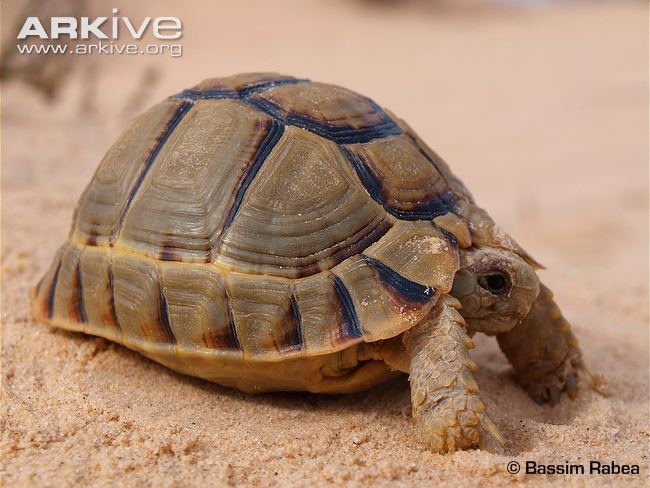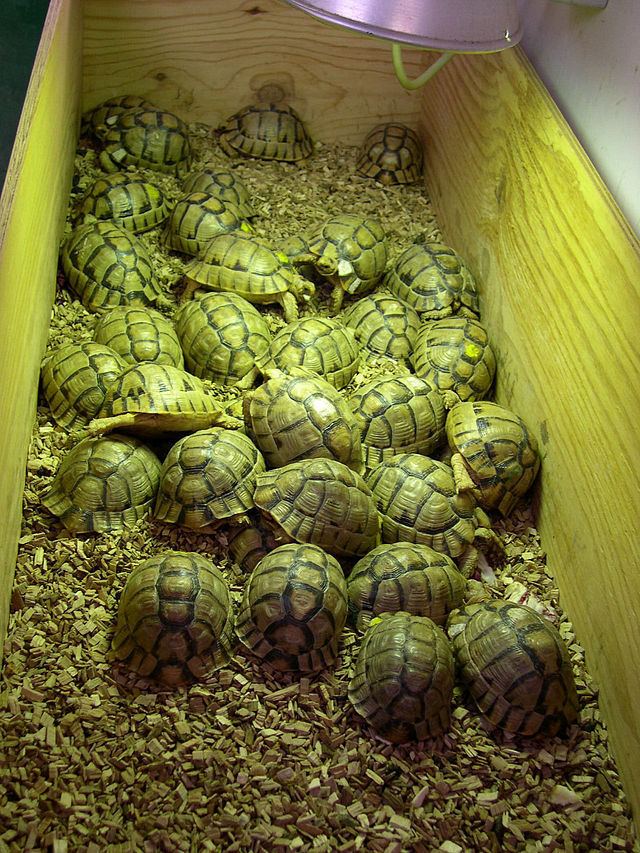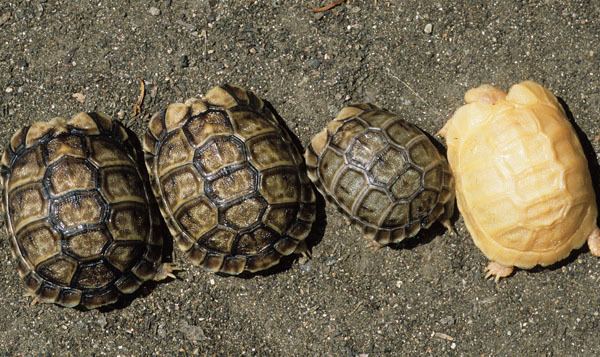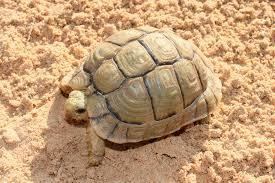Subphylum Vertebrata Rank Species | Phylum Chordata Order Testudines Family Testudinidae Higher classification Palearctic tortoises | |
 | ||
Similar Turtle, Tortoise, Palearctic tortoises, Reptile, Marginated tortoise | ||
Kleinmann s tortoise or the egyptian tortoise by spiderboy
Kleinmann's tortoise (Testudo kleinmanni ), often called the Egyptian tortoise and occasionally Leith's tortoise, is a critically endangered species of neck-hiding tortoise. Once more widespread, its numbers are now dwindling. The species is nearly extinct in Egypt, and complete extinction in the wild is a looming threat unless more actions are taken to protect this species.
Contents
- Kleinmann s tortoise or the egyptian tortoise by spiderboy
- Etymology
- Description
- Systematics
- Habitat and Ecology
- Reproduction
- Status and conservation
- References

Etymology

The specific name, kleinmanni, is in honor of Edouard Kleinmann, a French stockbroker who collected the holotype in 1875.
Description

Kleinmann's tortoise is the smallest tortoise in the Northern Hemisphere. Female tortoises are larger than the males; males are more slender and have a longer tail.

Their shells have high domes, and range in color from ivory to pale gold to dark brown to pink or dull yellow. This colouring strongly follows Gloger's rule, as it helps to regulate the impact of sunlight. This allows the paler tortoise to stay in the desert heat for longer. It is also an effective camouflage in the desert. The bottom of the shell is light yellow, often with two dark triangles on each abdominal scute. The tortoise's scutes have dark sidings that fade with age.
The head and limbs are a very pale ivory-yellow to yellowish-brown colour.
Systematics

The proposed subgenus Pseudotestudo is invalid, based on immature characters. It has been proposed to unite this species with the marginated tortoise in the genus Chersus. These clearly share a common ancestor with the spur-thighed tortoise (Greek tortoise). The former two are somewhat more similar to each other than to the Greek Tortoise regarding DNA sequence data. Considering biogeography, however, this is either due to (rather unlikely) dispersal across the Mediterranean, or the supposed "clade" is invalid and the similarity due to convergent evolution.

The Negev subpopulation has been separated as a distinct species, "Negev tortoise" (Testudo werneri). It does not appear to have distinct or strongly reduced haplotype diversity, consistent with the recent extinction of the Egyptian population (see below) and slow DNA sequence evolution rates in Testudo. It constitutes a locally adapted form, however, and is of distinct appearance. Arguably, it can be considered a subspecies and, as gene flow has ceased, the western and eastern populations must now be managed separately for conservation purposes.
Habitat and Ecology
Kleinmann's tortoises live in deserts and semiarid habitats, usually with compact sand and gravel plains, scattered rocks, shallow, sandy wadis, dry woodlands, shrubby areas, and coastal salt marsh habitats. In captivity, they eat grasses, fruits, and vegetables, but the diets of wild tortoises are unknown.
They are least active when the weather is very cold or very hot. During the colder months, they are out most during midday. During the warm season, they are active in the mornings and evenings. The rest of the day is spent under bushes or in rodent burrows.
Reproduction
Kleinmann's tortoises become sexually mature when about 5 years old. In the wild, mating has only been observed in March, but in captivity, they mate in April and August to November. During courtship, the male will ram the female, sometimes chasing after her. Unlike any other Mediterranean tortoise, T. kleinmanni may make a mating call similar to the call of the mourning dove. Eggs are laid in shallow bowls beneath bushes, or in vacant burrows. Each clutch contains one to five eggs, which hatch in the summer or early autumn.
Status and conservation
Once found in Egypt and Libya, their habitat in Egypt has been all but destroyed, and Egyptian tortoises are close to complete extinction there. Two populations can still be found in Libya, but much of the coastline habitat has been destroyed because of human activity. Habitat loss and the illegal pet trade are huge issues facing the species; it is also hunted locally for use in folk medicine. Their population is still on the decline, and the risk of extinction in the wild is very real if habitat degradation and illegal trade continue at their present rate.
On the IUCN Redlist, Kleinmann's tortoise is classified as CR A2abcd+3d. Less than three Testudo generations ago, an estimated 55-56,000 adult Kleinmann's tortoises existed. Today, about 7,500 remain, and decline due to habitat destruction and unsustainable exploitation appears to be ongoing. While the former threat is believed to be alleviated, illegal pet trade is feared to have reduced the population to maybe 1,000 adult tortoises in the two or three remaining subpopulations. Given that T. kleinmanni is a slow-maturing, long-lived species with few offspring (see K-strategist), This is well possibly less than the minimum viable population, eventually dooming the species to extinction in the wild.
Mixing individuals from the subpopulations for reintroduction purposes should be avoided, as the ecological parameters of habitat differ. DNA fingerprinting of individuals to help maintain heterozygosity in captive and reintroduction populations can be performed during routine stool analyses. In this context, notably, there may be a haplotype uniquely found in the Egyptian tortoise.
Captive breeding requires more care than in other Testudo species, as the species is more delicate and the clutch is very small, but is not highly difficult for experienced Testudo breeders. T. kleinmanni is not generally available for hobbyists and even if legal to keep, should be avoided without valid documentation. Smuggling continues to be a problem, but confiscated individuals are used to establish a captive safeguard population.
On May 21, 2007, Rome's main zoo, Bioparco, reported it has successfully bred the species from parents rescued from a smuggler's suitcase in 2005. It is also kept and bred at several other zoos in Europe and North America.
